





We have added some new faces to our team at Orchard Meadows Family Dental & Denture Clinic, making it easier than ever to schedule your next dentist appointment While we may be bigger, we promise you will get the same personalized care you expect from a small-town dentist office. We will even give you a fresh baked cookie after your visit!
Same day appointments available, so call today and see how Orchard Meadows Family Dental & Denture Clinic is making your comfort, care and happiness our top priority.

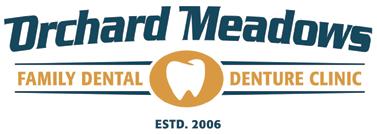












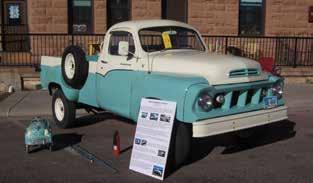


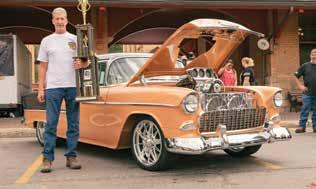





Black Hills Lifestyle CONTRIBUTORS
Account Executives
Kaylee Langseth 712-574-0618 | kaylee@michelscom.com
Patty Stover 605-390-2617 | patty@michelscom.com
Teresa Nestor 605-484-0918 | teresa@michelscom.com
graphic designers
Aaron Scott, Ashley Carrison, Flint Farley, Makenzie Jorgenson, Melissa Chinn
team of writers
Bridget F. Wall, Dan Daly, Dorothy Rosby, Maggie Jean Wince, Michaela Feldmann, Molly Barari, Natalie Frazier, Tami Hopp, Tanya Manus cover PHOTOGRAPHER
Open Spaces Photography 507-848-8745
Editor
Margi Culhane 605-940-4724 | margi@michelscom.com
DIRECTOR OF DIGITAL MARKETING
Cory Johnson 605-951-3567 | cory@michelscom.com
REGIONAL MANAGER BLACK HILLS/GSM
Kevin Culhane 605-661-8509 | kevin@michelscom.com
chief of operations
Hanna Michels 605-760-4269 | hanna@michelscom.com





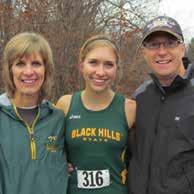
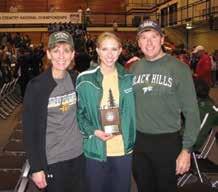
Top to bottom: Fall 2010 competing for BHSU at the NAIA cross country national meet in Washington state; post race photos with parents Craig and Karla Curran, All-American plaque 2009, Cross Country Race 2012


Since she was a sophomore in high school in Wahoo, Nebraska, Erin Fiedler has known what she wanted to be when she grew up. She was running cross country at the time and experienced a hip injury. An integral physical therapist worked with Erin, and from that point on, she knew she wanted to help people in the same way.
“I had been to physical therapy before and had a different outcome. It wasn’t until I was a sophomore that I experienced Postural Restoration – a type of physical therapy which emphasizes that all parts of the body are connected, and that the two sides of the system (right and left, dominant and non-dominant) must work together in a coordinated way to achieve balance– and my life changed for the better. From that point on, I knew I wanted to help people and give them back their quality of life, just like my physical therapist had done for me,” says Erin, now 33 and living in Sturgis.
Erin owns Peak Motion Physical Therapy, which has locations in Spearfish and Sundance. She started there as a therapist in 2021 after working at About You Physical Therapy in Rapid City and as a therapist in Lander, Wyoming, prior to that. She bought Peak Motion Physical Therapy in August 2022, realizing that she could do even more for the community.
I believe we all have unique talentsandgifts.I’vediscovered that my purpose in life is to serveothers. “ “
Erin moved to the area to go to college at Black Hills State University, where she was involved in cross country and track. Her family grew up vacationing in the Black Hills, and it had always felt like a second home to her. She appreciated the drier climate compared with southeastern Nebraska’s humidity as well.
After graduating with a major in exercise science and a minor in coaching, she headed back into the humidity to attend the University of Nebraska Medical Center in Omaha. There, she earned her Doctor of Physical Therapy degree in 2016.
Erin is passionate about her career as a physical therapist. She helps people of all ages who are having pain, headaches and dizziness. She also sees athletes who need check-ups before their sports seasons, and people who are trying to get into the best possible shape before or after surgery.
“I’m looking at the asymmetries in people, trying to turn off muscles that are overworking and turn on muscles that are underworking or underperforming. It’s about getting the body back into balance.”

Finding balance is key in Erin’s personal life, too. She is married to Trev, a shop teacher at Newell High School. The pair met at Black Hills State, where Trev also ran cross country and track. They will celebrate their 10-year wedding anniversary this July.
Erin and Trev have two young kids which keep them on their toes. Elsie is 5 and Isaiah is 3. Elsie will start kindergarten in the fall, and in another year, Isaiah will start preschool. The family enjoys being outdoors, taking bike rides together on the trail behind Fort Meade and going on hikes together with their beloved dog, Ember, a vizsla. Little Elk Creek near Piedmont is one of their favorite hikes. They also enjoy baking together.
“Elsie and Isaiah love helping mom bake, if only to lick the batter,” jokes Erin.
Running is still an important part of Erin’s life. She runs six days a week for six or seven miles at a time. Running is a time just for Erin, where she can clear her head and breathe more deeply. Her goal is to start training for another half marathon soon.
“Both of my parents are my role models,” says Erin. “They were both runners in college. That started the whole running bug. They took care of their health, which inspired me to do the same.”
“I always wanted to be the best version of myself, not just in running but in helping others and working hard, just like they showed me. They were invested in their community and helped wherever they could.”
Erin’s parents currently live in Wahoo but are planning to move to Deadwood within the next month, since it has been a dream of theirs to live in the Black Hills. They will be closer to Erin’s family and Erin’s brother, who lives in Rapid City.
When Erin is not working or spending time with her kids, she is involved in supporting other kids as a board member of Northern Hills CASA.
“Court-appointed special advocates act as liaisons between the child, the parents, the court, and all others involved in a child’s case to help the child find safe, permanent homes where they can thrive. I have a strong passion for kids and want to be a part of an organization that ensures that neglected and abused kids are taken care of,” she says.


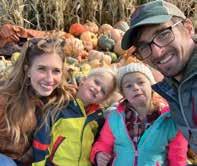

Erin’s faith is also at the center of her life. A member of St. Paul Lutheran Church in Spearfish, Erin is part of the Loaves and Dishes committee. “We cook and deliver food to anyone who needs it. We take food to families with new babies and to people with illnesses or injuries. For example, recently a gal fell, broke her pelvis and punctured a lung, and I made a meal and took it to her. It brought me joy to help her out and I know she appreciated it.”
Erin likes to take the time to pause and notice the world around her. She is constantly thinking about how she can do the most good—how she can leave things better than she found them.
That’s probably why she appreciates being involved in SD CEO West, an organization that promotes leadership and mentorship for women. Erin graduated from their Women in Leadership class in 2023.
The human connection is the most important part of Erin’s job. She meets new people each day, and she becomes part of her patients’ lives.
“I’m a tiny part of their story, but I get so much from patients, more than they realize.”
At the end of the day, Erin lives by these words. “I can do all things through Christ who strengthens me.”
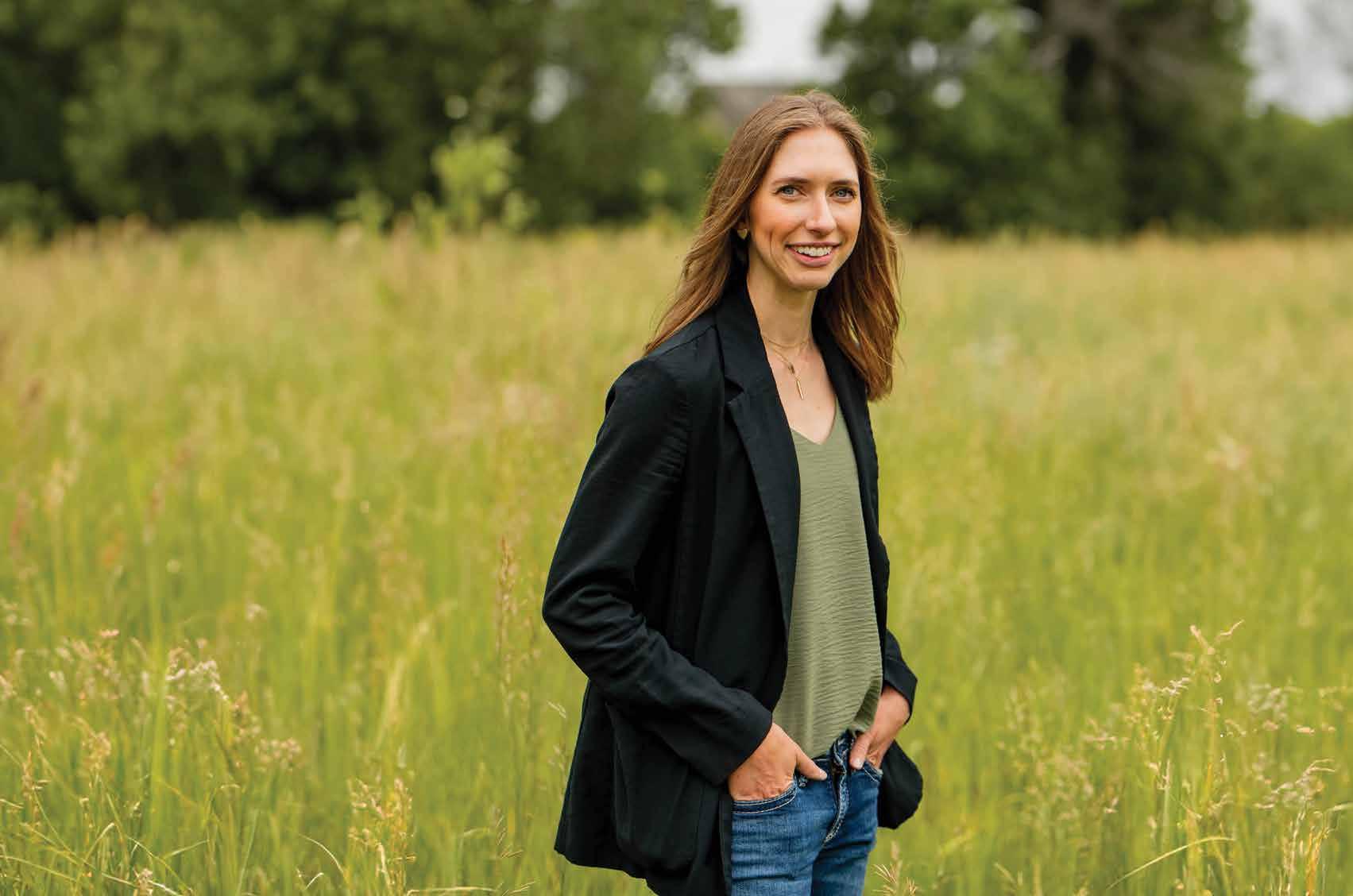
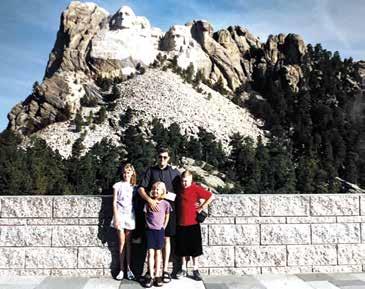
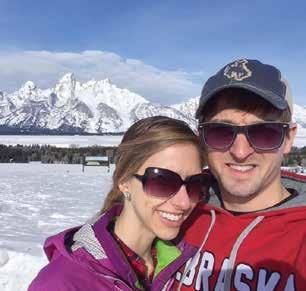


Erin has a sweet tooth. She is known to pick the piece of cake with the most frosting.
Erin loves traveling and went to Nicaragua on a medical mission trip while she was in school. “It was an eye-opener. I saw the disparities between what it’s like in the US compared with a third-world country. I saw kids scooping leftovers from open-air restaurants into their shirts to take them home. That’s not something I was used to seeing on the daily,” she says.
Erin enjoys DIY projects. “I get a little antsy and have to create or do something. I recently redid a dresser and my husband and I redid the front entryway in our house.”
Erin doesn’t watch a lot of TV, but when she does, she watches thrillers. Jack Ryan, Reacher and The Terminal List are some of her favorites.
Erin has hosted people at her house during the Rally since 2017. “We stay in our basement apartment and rent the house as an Air BnB. I’ve gotten to know people from all walks of life. I bake muffins for breakfast, and then I come home from work and make cookies. It’s almost like a family reunion. A lot of these people have seen our life change. The first year, we bought the house, then we got a puppy, then we had a baby. They’ve grown up with us, and we’ve grown up with them as their lives changed. I get a lot of joy out of it.” one two three four five

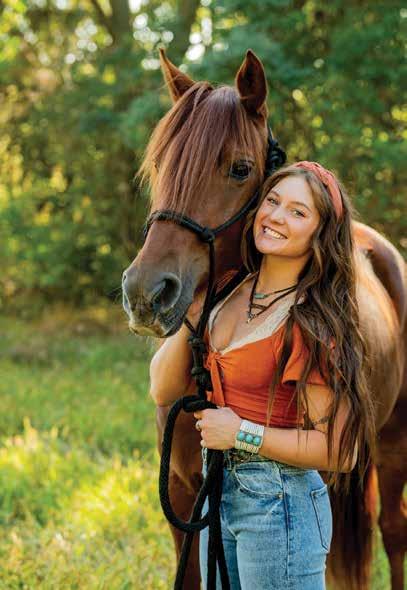











By Bridget F. Wall

When it comes to estate planning, there’s a lot to consider—especially if you will be leaving behind assets to your loved ones or heirs.
You may know that a will is where you’ll outline what you want to happen after you pass, including who inherits what. But how can you be sure that your wishes will actually be carried out? And what if you don’t have a will? That’s where probate comes into play.
Below, we explain what probate is, how it works, and why it’s such an important part of settling an estate. We also discuss key considerations you should keep in mind and offer advice that may help your estate avoid probate altogether.
PROBATE TERMS AND GLOSSARY
Before diving into the specifics of how probate works, it’s important to first understand a few key terms and how they relate to the process.
These include the following: Decedent: The deceased person
Estate: The decedent’s money and other assets to be distributed
Executor: A person named in the will to carry out, or execute, the instructions in the will (This will typically be a family member or close family friend but can also be a third–party, such as a lawyer.)
Administrator: A person designated by the court to administer a decedent’s estate instead of an executor (This typically occurs only when the decedent didn’t have a will or named executor.)
Beneficiary: A person (or organization, such as a charity) that should get property or assets in a will or other legal instrument, such as a life insurance policy
Creditor: A person or company to whom the decedent owed money
WHAT IS PROBATE?
Probate is a legal process designed to settle the decedent’s estate. What this process looks like will vary depending on whether the decedent had a valid will. The probate system oversees the distribution of the decedent’s assets to their new owners. This “court supervised” transfer can be to creditors, heirs or beneficiaries.
PROBATE WITH A WILL
A will contains a lot of important information, including who’s responsible for executing the

will (the executor) and who’ll inherit what assets (the beneficiaries).
When there’s a will, the probate process typically works something like this. First, the executor files the will with the probate court after the decedent’s death. The court then reviews and validates the will. Once validated, the executor is legally appointed by the court and allowed to carry out their functions.
These include:
• Identifying the decedent’s assets and appraising those assets (when necessary)
• Notifying the decedent’s creditors if the decedent carried any debts and paying off legitimate claims out of the estate’s assets
• Filing the decedent’s final personal income tax returns
• Paying any taxes the decedent owes (federal and state income taxes, property taxes, etc.)
• Distributing the decedent’s assets to any named beneficiaries
When a will isn’t present, the estate is deemed intestate. When this happens, the court appoints an administrator to serve the function typically played by the
executor. Other key steps—asset identification and appraisal, creditor notification, income tax filing, etc.—mostly stay the same as above.
The big difference lies in the distribution of assets. If the decedent didn’t have a will, the assets of the estate will be transferred to heirs according to the intestate laws of the state in which the decedent lived. While specifics can vary by state, this means that most assets will go to the spouse, children and other immediate family members of the decedent.
The lack of a will—and subsequent dispersal of assets—can sometimes cause disagreements between heirs. This is why creating a will is such an important part of the estate planning

Keep in mind that probate and intestate laws can vary significantly from state to state. When you start the estate planning process, be sure to check with your local laws and consult a lawyer.
Some things that can vary include:
• The timeline for filing a will or estate with the probate court
• The minimum estate size that triggers the need for probate
• The scope & depth of the probate process
• Who’s entitled to receive assets in the absence of a will
• And more
Probate serves an important legal purpose by helping ensure that a deceased person’s will and wishes are carried out. But that doesn’t mean it doesn’t have its drawbacks. Below is a look at the pros and cons that come with an estate in probate.
Advantages of probate:
Probate ensures the validity of a will: A key part of the probate process involves validating that the decedent’s will is legitimate and valid. This process can protect both the decedent and heirs from a forged, outdated or otherwise illegitimate will.
Probate allows for the distribution of assets without a will: If the decedent dies without a will, probate still provides a means of distributing the deceased’s assets.
Probate can help resolve disagreements: If there is a dispute among heirs and beneficiaries, probate offers a legal means of settling these disputes.
Probate provides court oversight: This helps prevent any potential misconduct or abuse of power by the executor or other individuals handling the estate.
Cons of probate:
Probate can be time consuming: The probate process can take months or even years from start to finish, depending on the complexity of the decedent’s estate and whether any disputes must be settled.
Probate can be stressful: The need to be involved in a long process can be stressful for family members who are expecting to get an inheritance. They may have to appear in person or coordinate with a legal representative who is working on their behalf.
Probate can be expensive: Settling an estate through probate usually includes attorney fees and court costs, such as filing fees, that can quickly add up to thousands of dollars.
Probate is a part of the public record: Because probate occurs as a part of the courts system, it means that the details of the decedent’s estate will become public record—which privacyminded individuals may not like.
If you want to avoid the potentially long time frames and high legal costs associated with probate, there’s good news: There are a number of steps you can take to settle your estate without needing to go through the courts.
Name and regularly update your beneficiaries. Certain types of assets can avoid probate if you list beneficiaries intended to inherit those assets upon your death. Most commonly, this includes retirement accounts, such as 401(k)s and IRAs, and the death benefit paid by a life insurance policy. Other options include payable-on-death (POD) and transfer-on-death (TOD) accounts (bank and investment accounts, respectively), which allow for named beneficiaries.
Take advantage of joint ownership.
If you share ownership of an asset or account with another person, it will typically transfer to them without needing to go through the probate process. If you and your spouse are both listed on the deed to a home, title of a vehicle, or bank account, your spouse would inherit your share of the property upon your death without triggering probate.
Consider establishing a living trust.
If you place your assets in a revocable living trust, you can name beneficiaries just as you would with a will. Upon your death, the trust would distribute these assets to your beneficiaries without needing to go through probate.
















Automotive legends are coming to the Black Hills for an unforgettable exploration of South Dakota history. On Labor Day weekend, Studebaker and Packard enthusiasts will take a driving tour to a site where Gen. George Custer’s storied expedition stopped in 1874.
This year marks the 150th anniversary of Custer’s journey through the Black Hills. Wagons made by Studebaker were part of the expedition. The 46th annual Studebaker and Packard Weekend in Custer on Aug. 30, 31 and Sept. 1 is planning the driving tour to recognize the Studebaker company’s contributions to Black Hills history.
The Labor Day weekend gathering is hosted by the Dakotas Chapter of Studebaker Drivers Club. The event is exclusively for Studebaker and Packard owners; Packard was purchased by the Studebaker company. Some vehicles that were subsequently manufactured had features of both Studebakers and Packards.
Studebaker and Packard owners from throughout the nation
will be arriving in the Black Hills. Representatives of the Studebaker family, who themselves own a Studebaker car, will be special guests.
The weekend’s most remarkable experience is sure to be the 150th Anniversary Exploring with Custer Tour on Aug. 31. Studebaker and Packard enthusiasts will drive to Deerfield, where Custer and his entourage camped for four days during the Black Hills Expedition of 1874.
“You will learn the folklore of George Armstrong Custer's stay. We will travel on paved roads following near the path Custer trekked across in Deerfield toward the present town of Custer, his namesake,” says Mary Coffin, chairman of the public relations and membership committees for the Dakotas Chapter SDC.
Custer’s mission was to explore the previously uncharted Black Hills, the sacred land of the Lakota Sioux, while also scouting for a suitable location for a new fort, finding a route to the southwest and investigating rumors of gold in the hills.
According to Mary’s research, Studebaker company products were part of the expedition. John Studebaker, co-founder of the company, produced wagons for the military and wheelbarrows for gold miners in California. He realized people heading west needed sturdy wagons to travel in, and Studebaker was one of the companies producing them in the 1800s.
“We know right before 1874 expedition that the U.S. government did buy a lot of big Studebakers, so we assume some wagons on the expedition were Studebakers,” Mary explains.
“A lot of people that buy Studebaker (vehicles) are people that like history,” Mary adds. “Our cars are different in that the Studebaker company started manufacturing cars in 1902 along with the Rambler that same year, predating Ford and other automobile manufacturers, but stopped production in 1965. Owners appreciate the mechanical innovations which Studebaker was developing and the advanced styling which distinguished them from other brands."
The tour will also travel to Keystone to learn more about gold mining in the region.
Author Paul Horsted of Custer will offer more insight into Custer’s expedition when he speaks to the group on Saturday, Mary says. Horsted is the co-author of the book “Exploring with Custer: The 1874 Black Hills Expedition,” which was updated and expanded in 2023.
“Custer was quite the promoter. He engaged several people to be writing journals, keeping notes and he engaged William Illingworth to take pictures,” Mary adds.
Horsted’s book includes new modern photos at 50 sites Illingworth photographed in 1874, plus new discoveries and additional material about the historic expedition.
Another highlight of the weekend will be the annual Car and Truck Show in downtown Custer. The public is invited to see dozens of Studebakers and Packards on display from 10 a.m. to 2 p.m. Sept. 1. Admission is free and visitors can vote for their favorites.
“Our show is nice because it has a variety of different models — some of the family models and some that are the high-speed, high-performance models, Avanti and Hawks. … We have a good variety of both restored and modified Studebakers and Packards. Last year we even had a Studebaker farm truck, which was relevant to a lot of folks,” Mary says.
“We’re a different niche of car show. If you want to open the door and sit down in them, you can,” Mary reports. “Our owners are right by the cars so visitors can ask them questions about why they like to own them and the vehicles’ attributes.”
Visit DakotaStudebaker.com for more information about the local club and the Labor Day event.
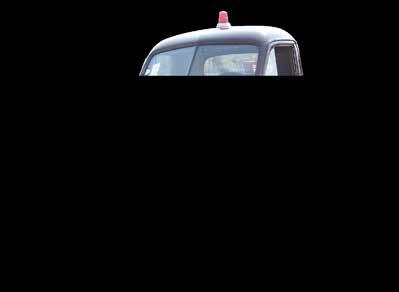







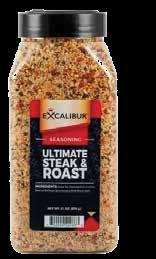






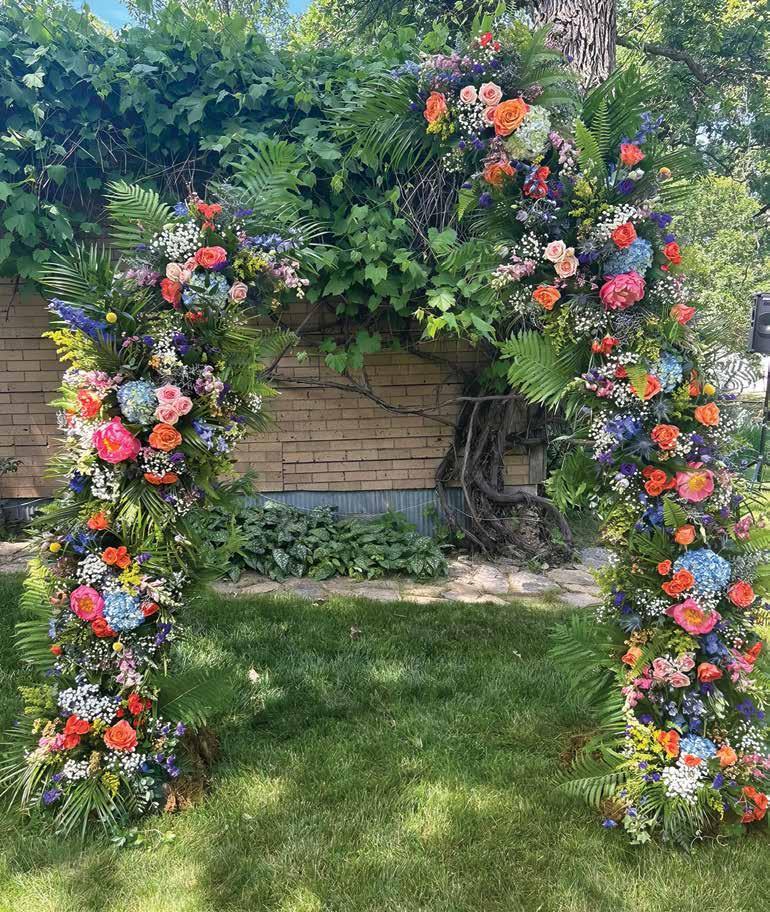


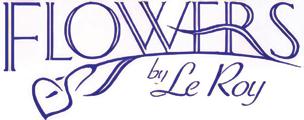





At Dakota Sky Stone, the jewelry-making process is more than just a craft—it’s a journey fueled by passion and driven by dedicated individuals that truly love what they do.
The process may be long, but the personal nature allows the family behind Dakota Sky Stone to insure it has been done right every single time. This commitment to overseeing each phase—from sourcing to final creation— ensures that every piece of Dakota Sky Stone jewelry is a testament to superior quality and artisanal integrity.
It starts with travel to the mines
Contrary to popular belief there is not just one type of turquoise stone. In fact, there are more than 30 different varieties with characteristics all their own to make turquoise jewelry attractive to a wide array of tastes and styles.
But, before the making of a piece begins for Dakota Sky Stone, the Tice family travels to different turquoise mines to hand pick stones for their pieces. According to Annie Tice-Poseley, the type of stone and its distinct characteristics are unique to whatever mine the stones are coming from and its geographical location.
“More of your Arizona mines carry more copper, so Arizona turquoise tends to be more blue in color, and Nevada turquoise carries more iron which adds more green shades into your turquoise,” Annie explains.
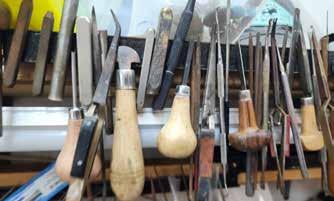

Specific grades of turquoise do not exist in the manner they do for other stones like diamonds. Typically, they look for stones that speak to them with beauty, matrix designs, and specific colors. Traveling to mines and finding stones has become an outlet for long lasting, cherished memories for the Tice family.
The many stages of a stone
Before they come together as finished jewelry pieces, the stones undergo a transformative progression in multiple, meticulous stages.
“There are so many stages of the stones,” Jim Tice says. “We have some turquoise that we have had for several years and we are now just getting into cutting it.”
“Once turquoise stones are cut, they then need to be backed and formed into cabochons. After that, the final cabochons are polished and ready to be used in a jewelry piece,” Jim explains.
As for the design process, stones are usually sent to artists so they are able to create with them and others are used by the Tice family to craft their own jewelry pieces. The passion for design and creation runs so deep they find themselves in their own workshop frequently making memories and creating together; something that is so enjoyable and essential to family bonding.
“If our family could, I think all of us would be in our design rooms all day every day. We all have such a passion for what we do,” Annie shares.
Annie’s personal design process usually looks like making a piece around one stone that she has really fallen in love with. Different qualities of a stone can allow the stone to speak to individuals on a personal level.
“My grandmother always told me that a stone will speak to you, and it chooses you,” Annie reflects. “I see it every day in the stores. People just gravitate to certain stones and sometimes surprise themselves because it wasn’t anything they thought they would like.”
Whether it is the unique color or matrices. Falling in love with your stones are essential in designing jewelry that you are really passionate about. The process of designing from stone to completion can take several months.
Several silverwork stages
To some customers the silverwork is what really draws them to a piece in the case at Dakota Sky Stone. That silver work process is made of a few intricate steps.
According to Jim, all Dakota Sky Stone silver work starts out as one sheet of silver where stones are laid out. After that the bezels for stones are created and soldered to the silver sheet. The whole design is then cut out with a jewelers saw and undergoes numerous stations of buffing and polishing. Once the buffing and polishing is complete, the stones are added back into the bezels to be finalized and set into the final piece.
The commitment to Native American culture and artistry
Dakota Sky Stone embodies a profound dedication to the nearly 280 Native American artists they collaborate with, ensuring the preservation and celebration of indigenous artistry and cultural traditions. With each piece of jewelry sold, they not only showcase the exquisite craftsmanship of their artisans, but also share rich histories and stories embedded in the stones and designs.
“I believe what makes Dakota Sky Stone most special is the idea that you are not just buying a piece of jewelry, you are learning the story behind the piece,” Annie explains. “Since our family works hand and hand in every aspect of making the jewelry, we are able to give them the history of the stone, artist and where it came from.”
From their family to yours
Dakota Sky Stone cultivates a unique bond with its customers by sharing their radiant passion for the craft they have invested themselves in. Whether it is picking out the piece that really speaks to you, learning a detailed history of the creation of your piece, or gathering around for a cherished story about their travels and business ventures, customers bond with the Tice family through their dedication.
“Another thing is our passion and love of what we do is shown in our designs, our stores and how we welcome our customers,” Annie states. “We always say you may walk into our store as a customer, but you always leave as a friend.”
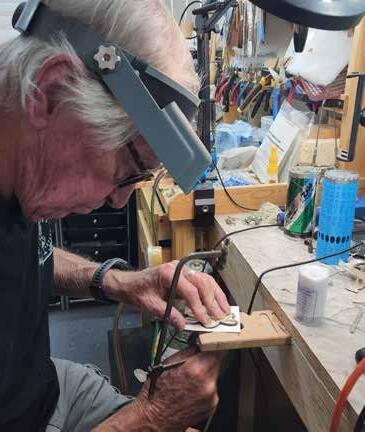
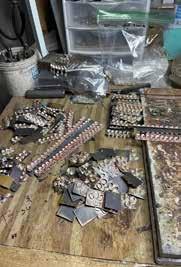





By Dorothy Rosby

How would you rate your navigation skills on a scale of one to 10, with 10 being “Who needs GPS?” and one being “I get confused getting in and out of my shower but I’m still a better navigator than Dorothy Rosby.”
If you said eight or above, you could stop reading right now. Actually you could stop reading now no matter how you rated your skills. It’s a free country. But you may want to read on if, like me, you prefer directions in terms of left and right because the words north, south, east and west are meaningless to you.
I heard the following on an episode of NPR’s Life Kit program. And I listened carefully because I’ve been deeply concerned about my navigation abilities ever since I got lost somewhere between my camper and the outhouse in a nearly vacant campground.
Let me preface this by saying that the information was more practical than some of the silly, old saws I used to hear like that one about moss on trees. I can never remember which side of the tree it’s supposed to grow on and I’m not sure the moss knows either.
I was also happy that these tips applied to both urban and hiking settings, since I’ve been lost in some of the finest of both.
On the other hand, I’m afraid to try some of them, including the first one:
1. Turn off your GPS. The experts interviewed on the program said that when we’re relying on technology to find our way, we’re probably not paying attention
to the cues around us. Go ahead and try this if you’re brave, but I don’t intend to. I hate to give up technology after I’ve finally learned how to use it.
Besides, I save so much travel time when I use Google maps because I don’t have to stop at every gas station on my route and ask for directions. And fortunately I don’t need technology everywhere I go. I never have any trouble getting to the post office or the grocery store.
2. Get lost on purpose. I’ve actually been using this tip my entire life—except the part about doing it on purpose. And so far it hasn’t been all that helpful. If getting lost had improved my navigation skills, I could be a tour guide or a big city taxi driver by now.
But I don’t mean to imply you won’t learn anything about navigation from getting lost. That’s how I learned not to turn off my GPS.
3. Remember to look back now and then. Someone could be tailing you. I read a lot of mystery novels so I worry about that.
The other reason you should look back occasionally is to ensure that your path looks familiar when you turn around to go back. Things look different from the other side. For one thing, the trees might be covered with moss.

4. Pick landmarks to orient yourself. But don’t make the mistake I’ve made more than once. Never pick landmarks that move. For example, wildlife, parked cars and ice cream trucks all make very poor landmarks.
The experts on Life Kit said the ideal landmark is large and far away, like a mountain or a tall building. That makes sense to me. I can see how noting your position in relation to a larger, distant object would be a good way to keep your bearings. Also those don’t tend to move.
5. Create a narrative about where you are. For example, “Hey, this is where we got into that argument about which side of a tree the moss grows on.” or “This is the corner where I rearended that UPS truck because I was looking for my turn.” I’ve never done that, but I can see how I’d remember the corner if I ever did.
6. And finally, pay attention. The experts didn’t come right out and say this, but I think they implied it. And I know not paying attention is part of my problem with navigation. My husband is usually in the driver’s seat, partly because he loves to drive and partly because I tend to doze off in a moving car. That makes paying attention difficult. It’s also not conducive to picking landmarks or looking back.

Dorothy Rosby is proud to say she hasn’t been lost even once since she heard these valuable tips yesterday. But then she hasn’t left the house since then.


Blackburn Foundation Repair makes stressful home repairs super easy with premium level care and expert level service.
Foundation repair
Basement waterproofing
Concrete repair
Crawl space repair
Radon testing and mitigation systems
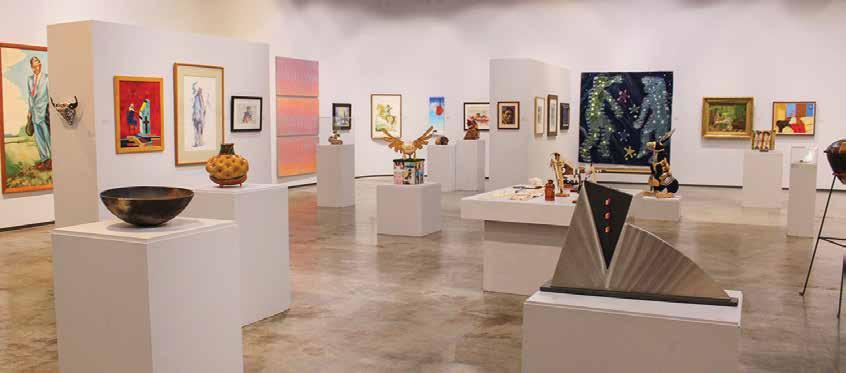
Written by Maggie Jean Wince, Rapid City Arts Council Staff
Nestled in the heart of Rapid City, South Dakota, the Dahl Arts Center serves as a vibrant hub for artistic exploration. Within its walls lies a hidden gem –the Permanent Collection, an evolving treasure trove of artworks meticulously curated by the Rapid City Arts Council to represent the region’s rich artistic heritage. Established in 1974, the collection tells the story of notable artists of the Black Hills and preserves their works for future generations to learn from and enjoy.
The story of the Permanent Collection begins with a generous donation – a set of 14 captivating paintings by the renowned artist Grace French, gifted by the Miser family in 1974. This act of artistic philanthropy set the stage for what would become a diverse and evergrowing collection. Since then, the Rapid City Arts Council (RCAC) has diligently built upon this foundation, acquiring over 300 artworks by 150 artists. Their

focus is clear: to showcase the artistic voices that have shaped the region’s cultural landscape.
Stepping into an exhibit of the Permanent Collection is akin to embarking on a visual journey through time and perspective. Here, you’ll encounter the captivating landscapes of Grace French, her Wooded Hillside and Florman Flume offer serene glimpses into the natural beauty of the Black Hills. Sharing the space are iconic works from globally recognized figures like Salvador Dalí’s Caballero (The Cowboy) and Marc Chagall’s dreamlike Couple en Ocre (Lovers in Ocre).
But the true heart of the collection lies in its celebration of regional voices. Artists like Lakota painter Oscar Howe captivate audiences with vibrant portrayals of his cultural heritage. Paintings like The Twins, Moccasin Seed Game Player, and The Sioux Chase offer a window into Lakota traditions and stories.
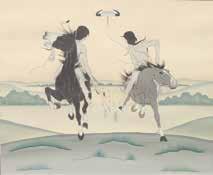


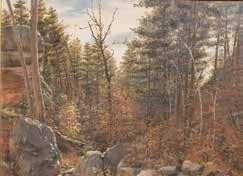
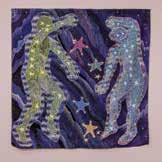




Pre-Order the Permanent Collection Catalog Now! thedahl.org/50years
The collection transcends the traditional, encompassing a range of artistic expressions. Dale Lamphere’s sculpture Zeus brings a touch of playfulness, while Lorri Ann Two Bulls’ Star Quilt #3 showcases the artistry and cultural significance of Native American textile traditions. Ray Tysdal’s Bride and Groom captures the essence of a timeless human experience, while Margaret Whiting’s Of the Universal Law of Nations delves into thought-provoking societal themes.
The inclusion of contemporary artists like Sarah Rogers, whose Piping Plover Chick highlights the fragility of nature, and Grete Bodogaard’s Heavenly Bodies, a stunning exploration of light and form, ensures the collection remains a dynamic entity, reflecting the artistic evolution of the region.
This summer, until August 31, 2024, the entire community has the opportunity to experience this remarkable collection firsthand at the Dahl Arts Center. Immerse yourself in the creative genius of the Black Hills, and discover the stories woven into each brushstroke and form.
Those who can’t make it in person can view the Collection online or purchase the Permanent Collection Catalog offering a chance to delve deeper into this artistic treasure trove. Regardless of how you engage, the Permanent Collection promises an enriching journey into the vibrant artistic legacy of the Black Hills region.





By Tanya Manus
The coolest cars and classic music take Deadwood by storm for Kool Deadwood Nites, and the party is only getting bigger and better. Kool Deadwood Nites is celebrating its 30th anniversary with new events, concerts, and a spectacular car show with more than 800 pre-1973 vintage vehicles.
“We’re adding and expanding in honor of the 30th anniversary!” said Amanda Kille, marketing and sponsorship director for the Deadwood Chamber of Commerce and Visitors Bureau.
Kool Deadwood Nites is adding an extra day, running from Aug. 20 to 25.
“All the entertainment on Tuesday is new. It’s the first time we are starting the event on Tuesday, Aug. 20, and we’re kicking it off in a big way!” Amanda said.
On Aug. 20, Mr. Wu’s is hosting a complimentary barbecue and a free concert by Eagles tribute band The Long Run. The Drifters take listeners back to the 1950s and 60s with a free concert on Deadwood Mountain Grand’s patio. Classic cars take over Deadwood’s historic Main Street for a Show and Shine from 6 to 9 p.m.
On Aug. 21, lunch in Sturgis is a new event for registered car owners. Music lovers can enjoy two new free concerts at Mr. Wu’s that evening — The Band Kandie and ZZ Top tribute band El Loco Fandango. Surfin Safari returns to Outlaw Square.
The new, free concert series continues at Mr. Wu’s with performances by West Bound and The Long Run on Aug. 22, Stereo Trip and Aeromyth “The Ultimate Aerosmith Tribute” band on Aug. 23, and West Bound and Bostyxx “A Tribute to Boston and Styx” on Aug. 24.


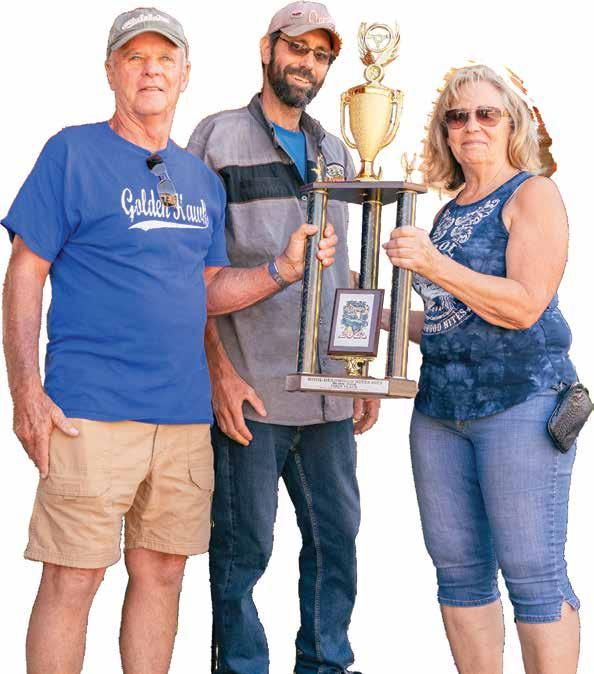




These concerts are in addition to the free concerts on Main Street, headlined by Herman’s Hermits starring Peter Noone, ABBA Revisited, and Elton Dan and the Rocket Band.
Also new this year, rock superstar George Thorogood wraps up Kool Deadwood Nites with a ticketed concert Aug. 25 at the Deadwood Mountain Grand.
Kool Deadwood Nites is offering a new, free parking shuttle in Lead in addition to the shuttle at Cedar Rose Spa, plus many favorite returning events. Visit deadwood.com/event/kooldeadwood-nites/ for a complete schedule of events and more information.
The legendary Kool Deadwood Nites car show, which started in the early days with several dozen vehicles, will showcase hundreds of cars and trucks this year.
Local experts volunteer their time to judge the show. Last year’s Best of Show winner was a coral and gray 1955 Bel Air owned by Deadwood area residents Mark and Kathy Johnston. That Bel Air graces the 30th anniversary Kool Deadwood Nites poster, and Mark said he’ll likely bring it and another one of his cars to this year’s show.
the majority of rebuilding and restoration work over about three years, replacing the engine, seats and upgrading the interior. Coral material that was original to a 1955 Chevy accents the door panels and seats, and Mark painted the car’s exterior himself.
“It was kind of a dream to build that car,” Mark said.
Car and truck aficionados who are looking to add a classic car, truck or memorabilia to their collection won’t want to miss the Kool Deadwood Nites Car Auction.
“The Kool Deadwood Nites Car Auction joined the lineup 20 years ago and brings an additional 200 cars to Deadwood that cross the auction block each year,” Amanda said.
McPherson Auction Co. runs the Kool Deadwood Nites auction, a three-day event that attracts bidders and buyers nationwide, according to Kevin McPherson, co-owner of McPherson Auction Co.

“This one (on the poster) is my 11th 1955 or 1956 Chevy I restored,” said Mark, who owns five that are fully restored and two more that are in the process of being restored.
“My first car was a 1956 Chevy when I was 15, and I have had them ever since,” Mark said.
The 1955 Bel Air was “a car in a box,” just a shell and boxes of old parts he bought from the retired owner of a body shop in Sturgis. Mark is proud that he did
Its nostalgic mix of timeless vehicles and music has made Kool Deadwood Nites one of Deadwood’s signature annual events, Amanda said.
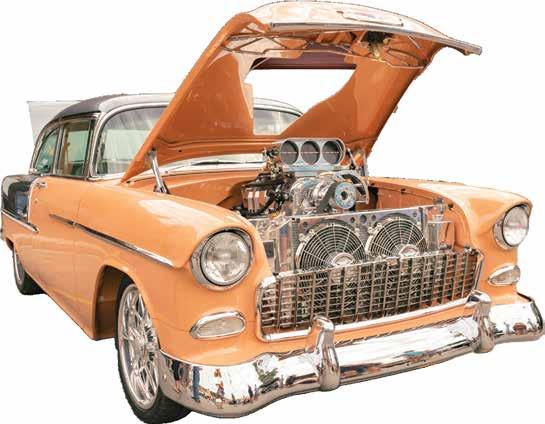

Kool Deadwood Nites owes its beginning to Willie Davison, creator of Hot August Nights in Reno, Nev., who brought the idea with him when he moved to Deadwood. Davison worked with local leaders and the Deadwood Chamber of Commerce and Visitors Bureau to create and launch Kool Deadwood Nites. 501




(605) 578-1876










































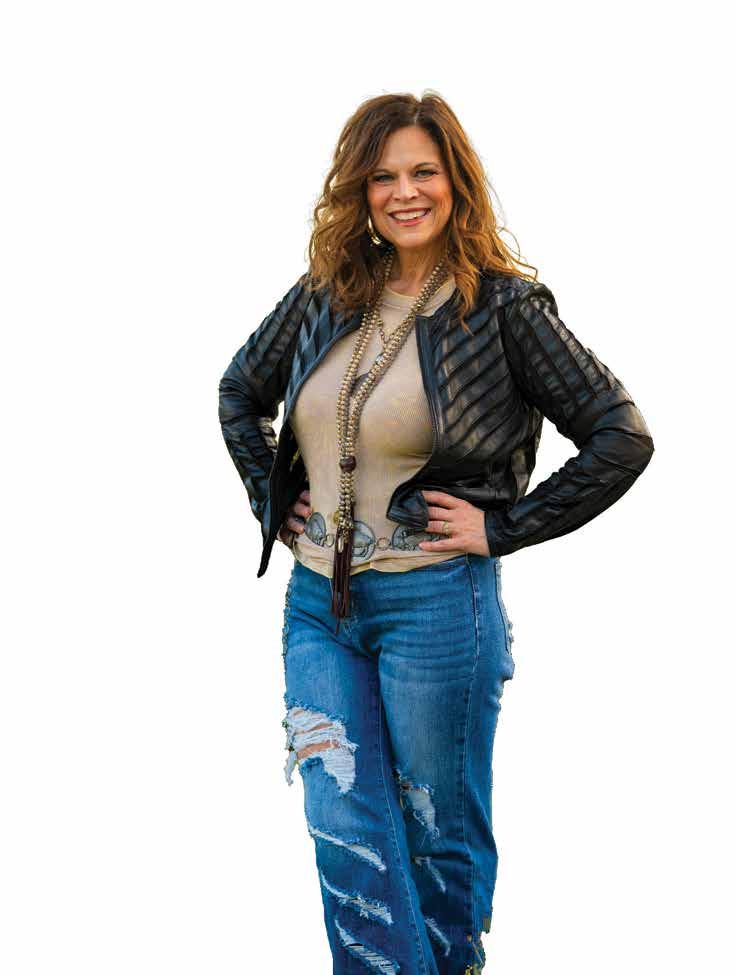





We’ve always believed that dining should be a social occasion, a time when friends, family, and coworkers can enjoy great conversation over a great meal.
We believe in supporting our local artisans and staying connected to our Black Hills community. At a time when the area is growing and expanding, we’re striving to keep the flavor of the region alive.
Inspired by the history of this area, both the aesthetics of the building and the diversity of the menu are true to our local roots, something no nationwide franchise can duplicate. Certainly, there are other steakhouses out there, but none like ours.





By Tamie Hopp
“Make-A-Will Month,” observed each August, serves as an excellent reminder about the importance of future planning for loved ones and causes that matter to you.
Planning for one’s own mortality is uncomfortable, and, for many people, talking about it with family members is even more difficult. This discomfort may explain why relatively few American adults have a will in place, even though most agree about the importance of advance planning.
“Nationally, 64 percent of adults surveyed agree it’s important to have a will,” said Tamie Hopp, Director of Philanthropy for the Black Hills Works Foundation, citing the annual Caring.com’s 2024 wills and estate planning survey. “Even so, only 32 percent actually have one.”
The Black Hills Works Foundation, a nonprofit supporting people with disabilities in Rapid City, hosts estate planning information sessions for families of adults with disabilities, connecting them with experts like attorneys and trust officers.
“Planning for an adult family member with disabilities who relies on programs like Medicaid and other public programs for support, adds another layer of complexity,” said Hopp. “Our free planning sessions help demystify the process a bit, and help families move forward with this essential work.”
Bequests, or trusts (often funded through a will upon the donor’s passing), are the most common ways professionals can help you provide for family members
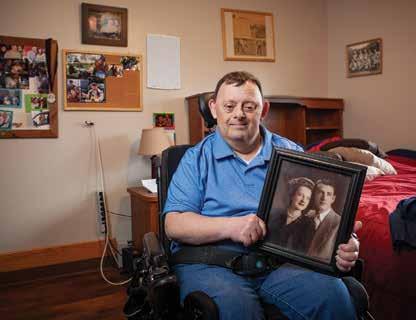
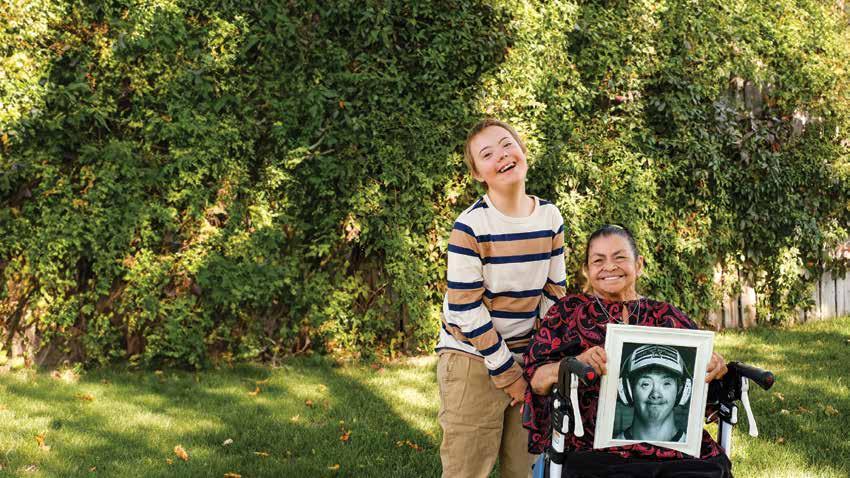
and make a lasting impact for the causes that matter most to you upon your passing.
Lois Perino wanted to make a lasting impact, so put plans in place that proved to be an enduring legacy for twelve organizations that mattered to her. She felt moved to support organizations helping people facing barriers or challenges.
“We were so heartened and grateful that Lois took the time make arrangements in her will to benefit Black Hills Works and eleven other worthy organizations,” said Hopp. “Through a simple will bequest, she changed countless lives.”
Having a will in place is also a gift to friends and family, as it serves as a roadmap of your intentions, making a difficult time of loss a bit easier. Lois didn’t share her estate plans with many people, including her close friend, Peggy Livingston, who Lois chose to administer her will.
“I was honored to carry out her charitable wishes and learn about the organizations that meant so much to Lois, including Black Hills works,” said Livingston.
Wilfred (“Shorty”) and Margaret Rasmussen, of Rapid City, understood the importance of carefully planning. Their legacy continues to benefit Rapid City-area children and people with disabilities, just as they did during their lifetime. Since the mid-1990s, following their deaths, the Wilfred & Margaret Rasmussen Trust, provide for in their wills, has contributed well over a million dollars to area nonprofits supporting children and people with disabilities.
Lyndell Petersen, trustee and Shorty’s close friend, is heartened, but not surprised, by his friend’s legacy.

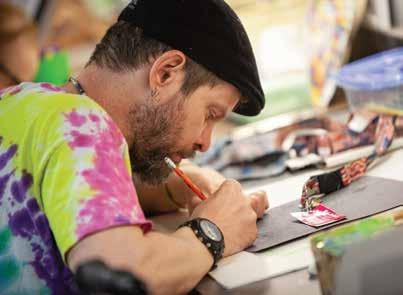

“Shorty and Margaret didn’t have children of their own, so they supported kids in the community who might otherwise go without,” said Petersen, also a trustee to the Rasmussen. “They bought trophies for the Western Junior Livestock show reserve champions and hosted an annual Christmas party for the Boys Club. The kids loved them, and they loved the kids.”
Sara Gentry, Executive Director, Rapid City Club for Boys Foundation, agrees. “There are people on staff who still remember Shorty and Margaret fondly. They were so generous and genuinely seemed to enjoy their connections to the kids.”
The Rapid City Club for Boys, along with Black Hills Works and Girls Incorporated, are among the local organizations that have received annual gifts from the Rasmussen Trust for nearly three decades.
“I can’t overstate the meaningful impact Shorty and Margaret have had on the lives of the people we support,” said Hopp. “Because of them, our arts expression programs – Flutter Productions and Suzie Cappa Art Center – are thriving; homes supporting hundreds of people with disabilities have been
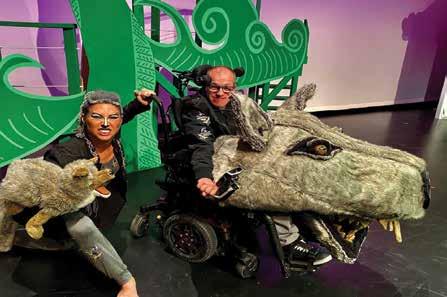

upgraded and made more accessible; therapeutic sensory rooms are now in several homes; and so much more.”
“They continue to impact the lives of the boys through their trust,” said Gentry, sharing that the Rasmussen Trust has funded Club for Boys’ program supplies for the educational, outdoor, recreation and sports programs. “They have left a meaningful legacy.”
“They would love that they are being remembered in this way,” said Shorty’s close friend, Lyndell.
Your personal roadmap to providing for family and causes that matter to you – your legacy - begins with your estate plan. With this being “Make-A-Will-Month,” there is no better time to start. Your planning today will change the lives of those you care about tomorrow.

Black Hills Works Foundation 514 Mount Rushmore Road Rapid City, SD 57701 (605) 343-4550
www.blackhillsworks.org
Cryo Sculpting is the #1 alternative to other fat freezing technologies such as CoolSculpting®.
Why choose CoolCRYO’s Cryo Sculpting?
Kills fat permanently, tightens & brightens skin
Target nearly any body part
No BMI or weight restrictions like other non-surgical fat reduction treatments
Most see results in WEEKs instead of months
Faster treatment times & no excessive costs
No surgery. No downtime
Lose inches, correct cellulite, & tighten skin without surgery, needles, chemicals or downtime. Hack your body to health with our cutting-edge wellness services!


Scan the QR Code to activate your 50% OFF
Fat Freezing voucher
My name is Cat, I’m a first grade teacher here in Rapid City...I came in at a size 16, now I’m a size 8. I’ve been coming for 2 years now, I feel more confident in my appearance, I don’t hide behind people anymore when taking pictures, It has definitely helped my self-esteem and confidence.
Anyone who is skeptical about CoolCRYO should definitely come in for a free consultation. It is definitely worth the investment & time-It has been an amazing experience for me.
Cat, First Grade Teacher
We’ve treated hundreds of clients and performed thousands of fat reduction treatments.
We are the only location in all of South Dakota to have the most advanced state-of-the-art body contouring equipment.

Rapid City’s premier state-of-the-art aesthetic, wellness & recovery clinic
4040 Cheyenne Blvd, Suite C
Rapid City, SD 57703
(605) 301-3190 (text or call)
hello@coolCRYO.com
coolCRYO.com
By Dan Daly

Monument Health’s Heart and Vascular Institute continues to offer the latest in cardiac and vascular care in the Black Hills and beyond.
For most of us, our daily to-do list is pretty routine. But for the cardiologists and surgeons at the Monument Health Heart and Vascular Institute (HVI), the to-do list is anything but routine. For them, a typical list might include:
Cut open a human being’s chest, stop the beating heart, graft leg veins onto the heart to bypass clogged arteries and restore blood flow to the heart muscle. Then restart the heart, close the chest.
Insert a catheter into a patient’s arm or leg, thread it through the arteries to the heart, using tiny tools to break up plaque, replace or repair heart valves or insert a stent to keep blood flowing.
Implant a mechanical pump to assist a failing human heart until the patient can be treated at a transplant hospital.
Return to the hospital for a late-night angioplasty procedure, because heart attacks don’t keep regular office hours.
The team at HVI has been performing life-saving treatments for patients in western South Dakota and neighboring states for more than three decades. And despite all of the advances in the science of heart health, the team at HVI remains at the forefront of cardiac and vascular care.
Today, HVI’s team includes board-certified specialists in electrophysiology, cardiovascular surgery, interventional cardiology, nuclear cardiology, endovascular medicine and other diagnostic fields. Facilities include two cardiac and vascular surgical suites, two catheterization labs, an electrophysiology lab, an electrology device lab and a hybrid suite with state-of-the-art imaging equipment.
Cardiologist Alex Schabauer, M.D., FSVMB, FACC, came to the Heart and Vascular Institute in 1996, after completing a fellowship at the Mayo Clinic. He said HVI has been successful and growing because the physicians, providers and staff remain committed to quality patient care and to the community they serve.
“If the focus remains on the patients and the quality of care, it always goes well. If you get distracted by the associated business interests, rather than care, you quickly go down the wrong rabbit hole,” Dr. Schabauer said.
The Heart and Vascular Institute, which celebrated its 30th anniversary in 2023, began as Cardiology Associates, PC, Heart Doctors. The original founders wanted to develop a comprehensive cardiology practice to better meet the needs of their patients, according to founding partner Drew Purdy, M.D. That’s still the goal of HVI, which now has 10 cardiologists, one heart surgeon, one advanced heart failure specialist, one electrophysiology specialist and 31 advanced practice providers.
For nearly 15 years, Cardiology Associates/Heart Doctors operated as a private clinic not affiliated with the hospital. In 2009, the group merged with Regional Health, now known as Monument Health. Dr. Schabauer said the relationship between HVI and Monument has been strengthened by a shared vision and a commitment to advancing the practice of cardiac care in the region.
HVI serves patients from throughout western South Dakota as well as Nebraska, Wyoming, Montana and North Dakota. Also, cardiologists and advanced practice providers travel to outreach clinics in 10 communities, as far away as Philip, Gillette, Wyo., and Alliance, Neb.
The cardiologists and cardiothoracic surgeons at HVI are at the forefront of technology of cardiac and vascular care. In some cases, they helped develop the technology or participated in clinical trials, giving West River patients access to the latest treatments. Some examples:
Catheter-based Structural Heart Treatments – The Structural Heart Team at Monument Health offers state-of-the art treatment for patients with abnormalities of heart valves and heart chambers. From transcatheter aortic, mitral, and tricuspid valve replacement/ repair to fixing holes in the heart using patches without requiring

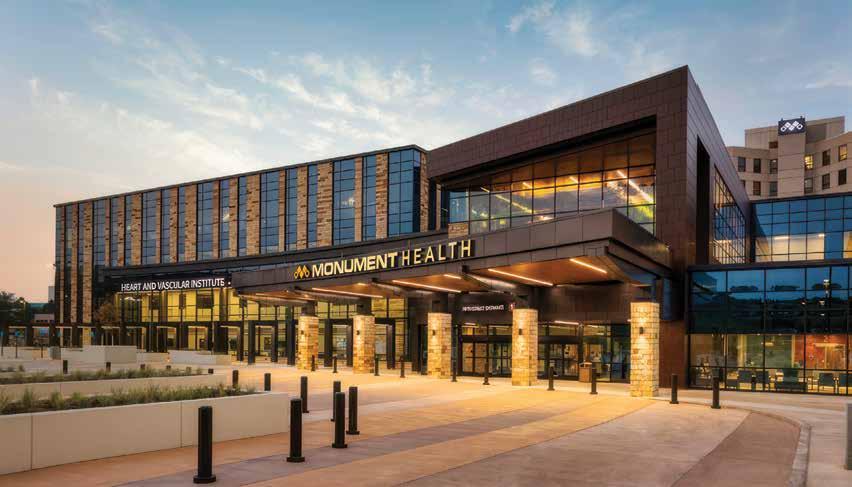
a chest incision, our physicians perform the latest non-invasive procedures available. Regardless of the severity or complexity of your heart disease, the Structural Heart team at Monument Health has you covered.
Venous disease treatments – The team has made advances in the care for vein problems ranging from impaired blood flow to more serious cases where patients have wounds that won’t heal.
Advanced heart failure – HVI is extending its cardiac services to treat advanced heart failure. This includes a partnership with the University of Minnesota, a world leader in cardiovascular care, and in collaboration with Mayo Clinic and other centers. Luis Hernandez, M.D., FACC, completed an Advanced Heart Failure and Transplant Cardiology fellowship at the Cleveland Clinic. His work can include increased medical management or use of a left ventricular assist device (LVAD), a small pump that assists the heart. Dr. Hernandez serves as an expert clinical conduit between patients and the region’s transplant hospitals.
Complex arrhythmia treatment – For heart rhythm abnormalities, the Electrophysiology and Complex Arrhythmia team at Monument Health offers the newest technology available for treatment of heart rhythm problems. This includes pacemaker placement for slow heart rhythms, and minimally invasive catheter-based ablation for atrial fibrillation, atrial flutter, and ventricular tachycardia caused by short-circuiting electrical impulses. For patients who don’t respond to minimally invasive procedures, HVI offers the convergent procedure, where the heart surgeon ablates the rhythm through a small chest incision.
Peripheral artery disease – HVI’s PAD Treatment team has extensive experience in diagnosing and treating this type of disease. Treatment can range from lifestyle changes and medication to angioplasty and stent placement, opening clogged arteries in the arms, legs, and kidneys. The physicians inflate a tiny balloon to widen the blocked artery or clear the cholesterol plaque out using a small device in order to improve blood flow. A small wire-mesh tube, or stent, can keep the artery open. In some cases, bypass surgery is performed.
Given the increasing complexity of cardiac and vascular care, as well as the long travel distances to major university hospitals, this type of collaboration between physicians, HVI and Monument Health benefits the entire West River community, Dr. Schabauer said.

FACC
353 Fairmont Boulevard
Rapid City, SD 57701
(605) 755-4300
monument.health/services/heart-vascular-care
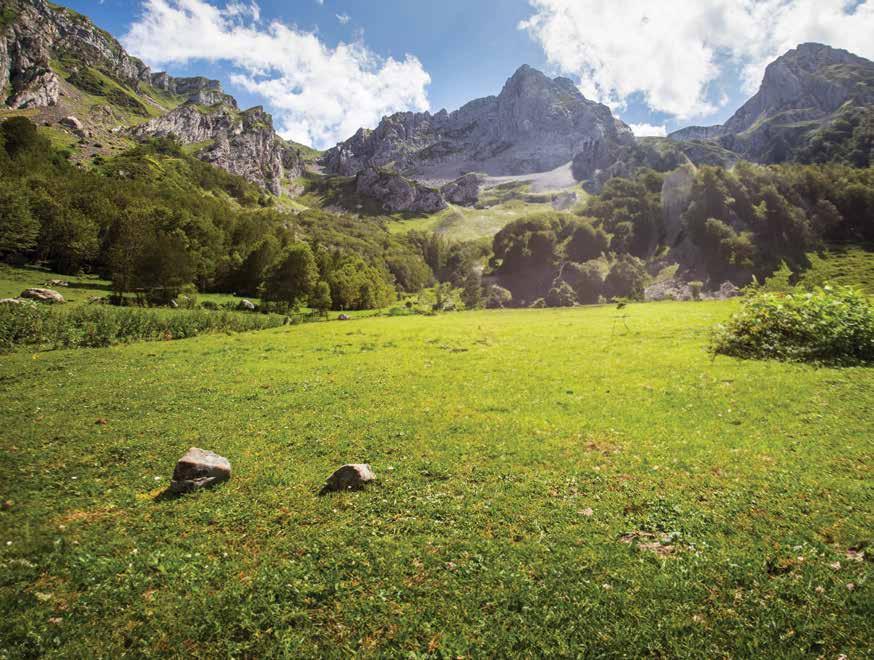


Whether you are looking for new or used tires or just need your horse trailer ready for the road, bring it by Tyrrell Tires as soon as possible and we will diagnose the problem for you. We have a wide range of services and carry top-of-the-line products to accompany them. Our skilled employees will provide you with full service and quality repairs for all your vehicle or trailer needs!
• Truck and Auto Accessories
• Custom Wheels
• Race Car Parts and Race Fuel
• We Stock All Major Tire Brands
• Mobile Tire Service
• Brakes
• Oil Changes
• Suspension, Shocks, and Struts
• Level, Lift, and Lower Kits
• Automotive Repairs

STORE HOURS
MON - THURS: 8:00AM - 5:30PM FRIDAY: 8:00AM - 5:00PM
SATURDAY: 8:00AM - NOON
SUNDAY: CLOSED
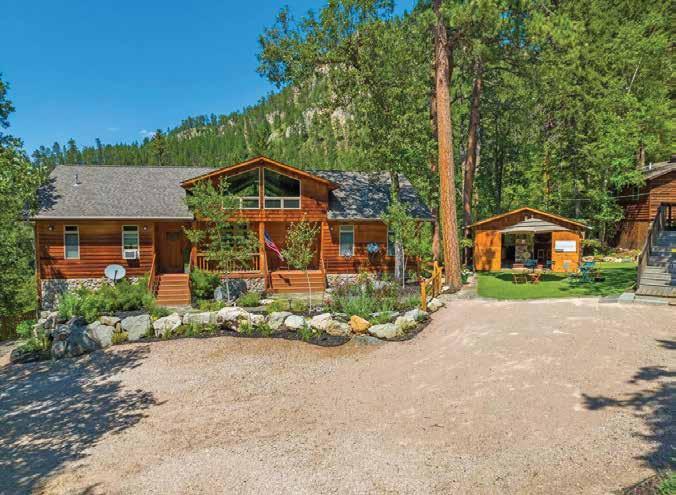



Exclusive 6.29 acre retreat in the Black Hills
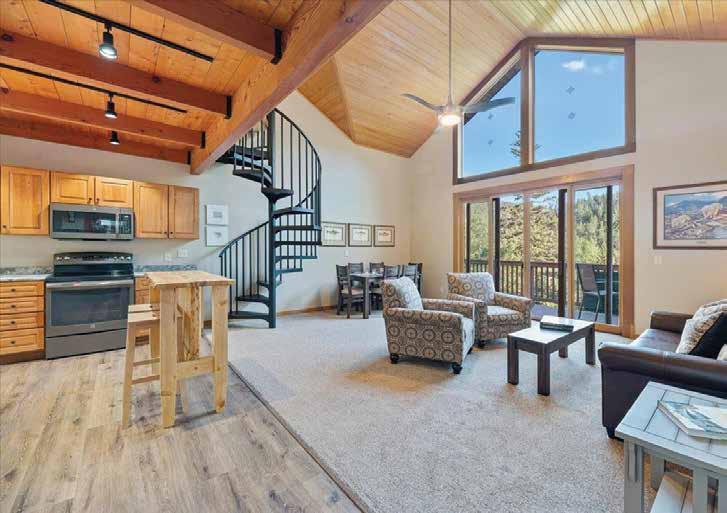

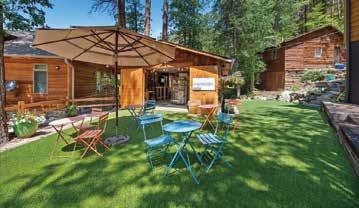


Discover the epitome of luxury & tranquility with this exclusive retreat in the beautiful Black Hills of South Dakota.
Nestled on 6.29 acres in the breathtaking Spearfish Canyon, Rim Rock Lodge is just 5 miles from the vibrant community of Spearfish & surrounded on 3 sides by National Forest.
This turn-key property can be converted to residential zoning & used for a legacy property or a multiple owner vacation property! With property taxes under $5,000 a year, this property is truly unlike any other!
The estate includes six charming cabins, a stunning owner’s suite, three luxury guest suites, a historic 1919 lodge with expansive decks and a kitchen ideal for catered events, and a cabin off the main house that has endless uses!
This property offers a lifestyle of adventure and relaxation, being just minutes away from skiing, snowmobile trails, hiking, and mountain biking. This property presents endless opportunities for growth.
Indulge in a life of luxury & adventure with Rim Rock Lodge – a rare & unparalleled opportunity for buyers seeking a unique investment & lifestyle property in the heart of the Black Hills.






WHAT DO YOU CONSIDER THE BIGGEST ADVANTAGE OF WORKING WITH A REALTOR®?
One of the biggest advantages of working with a realtor is their expertise and knowledge of the real estate market. We have a deep understanding of the local market trends, prices, and neighborhoods, which can be invaluable when buying or selling a property.
WHAT IS THE MOST GRATIFYING PART OF YOUR JOB?
The feeling of accomplishment and contentment that comes from seeing my clients genuinely happy and settled in their new residences is unparalleled.
WHAT IS YOUR GREATEST STRENGTH AS A REALTOR®?
My strength in communication allows me to establish strong connections with my clients, provide them with the information they need, and advocate for their best interests. It is through effective communication that I can deliver exceptional service and help my clients achieve their real estate goals.
DO YOU HAVE A PERSONAL MOTTO OR FAVORITE QUOTE?
"A satisfied customer is the best business strategy of all."- Michael LeBoeuf


DESCRIBE YOURSELF IN THREE WORDS:
Plan Ahead
What is something people might not know about you?
One thing that people might not know about me is that I am currently in the process of submitting my test scores to Mensa.

Welcome to your dream retreat! This stunning property, built in 2023, sprawls across 5.95 acres of serene landscape, offering a perfect blend of luxury & natural beauty with towering pine trees framing breathtaking views. Inside the 2911 sq ft home, discover 4 bedrooms & 2.5 baths, including a spacious primary bedroom suite with a luxurious ensuite bathroom and laundry facilities. Additional bedrooms provide ample space for guests, while a versatile fourth bedroom offers flexible usage options. The heart of the home lies in the meticulously designed kitchen with a large island, quartz countertops, and a massive pantry with additional refrigerator and open storage. Adjacent, the living room features a cozy fireplace and vaulted ceilings, ideal for unwinding or hosting gatherings. Step outside to your own outdoor oasis, complete with a pool and hot tub. With city utilities, this home offers both convenience and freedom, minutes away from Monument Hospital, downtown Rapid City, and I-90.


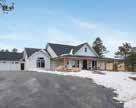



A cozy chair adorned with a plush pillow, offering a perfect spot for relaxation and contemplation. A neutral tone blends seamlessly with any decor.
A charming wooden chair featuring a comfortable and stylish striped cushion design, combining rustic charm with modern flair.

A luxurious gray chair, embellished with elegant nailhead trim, exuding sophistication and comfort.

A stylish tan leather chair, complemented by a cozy throw pillow, exudes timeless elegance and comfort. The supple leather offers a smooth and inviting texture, while the throw pillow adds a touch of personal charm.








By Michaela Feldmann
Buying a home is no simple task. Thankfully, when you work with Top Shelf Construction, you’re never alone.
“We really believe in giving our clients a full, well-rounded experience with us,” says Chandler Kubas, owner and CEO of Top Shelf Construction. “We are here for them no matter if they’re building a home from the ground up or getting ready to purchase a completed home.”
But doing so can feel overwhelming for many homeowners. Where do you start? What lending options are available and who do you trust to help you walk through this complicated process?
“That’s when we bring in TruView Lending to the equation,” says Kubas.
Located in Phoenix, Arizona, TrueView, powered by New American Funding, is a trusted partner of Top Shelf and Kubas himself.
“Chandler and I have known each other for a little over a year now,” says Michelle Collins, Senior Loan Officer and Vice President of Talent and Culture for TruView. “We met through a local real estate partner in Arizona and just became fast friends.”
That friendship soon led to a partnership between TruView and Top Shelf.
“Top Shelf really is a family organization that truly believes in values and loves the community. I want to work with people who have a real vested interest in my community and other communities and that’s exactly what Top Shelf does. In turn, Chandler and I work together to bring value to his customers,” Collins adds.
One way they bring value to homeowners is through the lending process.
“It is such an overwhelming experience,” says Collins. “Buying a home is very individualized. It’s like a thumbprint – no two are the same. No two credit histories are the same. No two savings patterns are the same and no two debt ratios are the same. Everyone has their own story and what they bring to the table.”
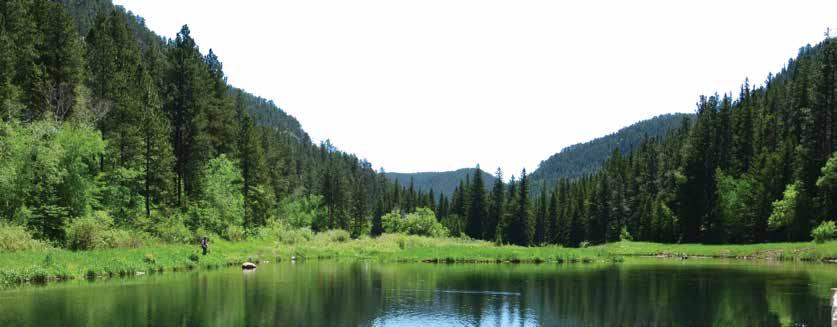
That includes homeowners purchasing their first or second home.


“The Black Hills area really speaks to second homeowners that may be coming down from North Dakota or from California. Top Shelf also has a couple of different subdivisions at different prices whether that’s familyfriendly or more luxury price points. Some come in with cash and are ready to go and others have the minimum down payment and need help. We guide them through homeownership and can help them with as little as 3% down and upward from there.”
That’s why Collins says having different options is crucial.
“I have the opportunity to educate the consumer and really explain the process in layman’s terms. Then, they get to pick the best choice for themselves or their family.”
When you work with Top Shelf and TruView, they provide incentives to help you in the process.
“Most often the client chooses to use those incentives to help with interest rates or closing costs. They want the lowest rate possible. We often take that money as a temporary or permanent buy-down. Maybe they use it to cover their closing costs or we could take it off the top of the purchase price. There’s just a bunch of different options.”
Collins says it’s about understanding what the client wants and needs, and even though they’re located in Arizona, technology has helped keep her connected to clients in the Black Hills.
“Technology allows the client to easily complete an application, communicate with me and upload their private documents confidentially. But it’s also provided vehicles like zoom and teams where we can get on video chat, meet each other, see each other and feel like we are getting to know each other. Now I can happily and confidently do business with people outside of my little world.”
Another way Top Shelf and TruView are helping communities is through an exclusive lender option called My Blue Collar. The program works to assist people that work in trades like electricians, construction workers, plumbers, roofers or welders.
“These people basically build America. It helps provide them with additional benefits on top of what we just talked about,” says Collins. “Then our real estate partners are providing additional concessions to help with things like closing costs and interest rates, and we are excited to share that we will officially launch that program in Rapid City as the first in the nation.”
“Michelle and the TruView team are very generous and knowledgeable people,” says Kubas. “I’ve been to their facility in Arizona and they can definitely handle the demand. Plus, they are really down-home people and that’s very important when dealing with customers. We want to make sure that they feel heard. Everyone’s financial situation is different and TruView has a lot of different options to offer. We are proud to work with them.”






